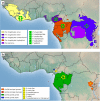Wild African great apes as natural hosts of malaria parasites: current knowledge and research perspectives
- PMID: 32110692
- PMCID: PMC7041518
- DOI: 10.5194/pb-4-47-2017
Wild African great apes as natural hosts of malaria parasites: current knowledge and research perspectives
Abstract
Humans and African great apes (AGAs) are naturally infected with several species of closely related malaria parasites. The need to understand the origins of human malaria as well as the risk of zoonotic transmissions and emergence of new malaria strains in human populations has markedly encouraged research on great ape Plasmodium parasites. Progress in the use of non-invasive methods has rendered investigations into wild ape populations possible. Present knowledge is mainly focused on parasite diversity and phylogeny, with still large gaps to fill on malaria parasite ecology. Understanding what malaria infection means in terms of great ape health is also an important, but challenging avenue of research and has been subject to relatively few research efforts so far. This paper reviews current knowledge on African great ape malaria and identifies gaps and future research perspectives.
Copyright: © 2017 Hélène Marie De Nys et al.
Conflict of interest statement
The authors declare that they have no conflict of interest.
Figures

Similar articles
-
Zoonotic Transmissions and Host Switches of Malaria Parasites.Zoonoses. 2021;1(1):11. doi: 10.15212/zoonoses-2021-0015. Epub 2021 Nov 2. Zoonoses. 2021. PMID: 35282332 Free PMC article.
-
Mitochondrial genes support a common origin of rodent malaria parasites and Plasmodium falciparum's relatives infecting great apes.BMC Evol Biol. 2011 Mar 15;11:70. doi: 10.1186/1471-2148-11-70. BMC Evol Biol. 2011. PMID: 21406081 Free PMC article.
-
Anopheles moucheti and Anopheles vinckei are candidate vectors of ape Plasmodium parasites, including Plasmodium praefalciparum in Gabon.PLoS One. 2013;8(2):e57294. doi: 10.1371/journal.pone.0057294. Epub 2013 Feb 20. PLoS One. 2013. PMID: 23437363 Free PMC article.
-
Ape Origins of Human Malaria.Annu Rev Microbiol. 2020 Sep 8;74:39-63. doi: 10.1146/annurev-micro-020518-115628. Annu Rev Microbiol. 2020. PMID: 32905751 Free PMC article. Review.
-
Out of Africa: origins and evolution of the human malaria parasites Plasmodium falciparum and Plasmodium vivax.Int J Parasitol. 2017 Feb;47(2-3):87-97. doi: 10.1016/j.ijpara.2016.05.008. Epub 2016 Jul 2. Int J Parasitol. 2017. PMID: 27381764 Free PMC article. Review.
Cited by
-
Urinary neopterin levels increase and predict survival during a respiratory outbreak in wild chimpanzees (Taï National Park, Côte d'Ivoire).Sci Rep. 2018 Sep 6;8(1):13346. doi: 10.1038/s41598-018-31563-7. Sci Rep. 2018. PMID: 30190614 Free PMC article.
-
Plasmodium pitheci malaria in Bornean orang-utans at a rehabilitation centre in West Kalimantan, Indonesia.Malar J. 2022 Oct 3;21(1):280. doi: 10.1186/s12936-022-04290-8. Malar J. 2022. PMID: 36184593 Free PMC article.
-
An Ecologically Framed Comparison of The Potential for Zoonotic Transmission of Non-Human and Human-Infecting Species of Malaria Parasite.Yale J Biol Med. 2021 Jun 30;94(2):361-373. eCollection 2021 Jun. Yale J Biol Med. 2021. PMID: 34211355 Free PMC article. Review.
-
Malaria-driven adaptation of MHC class I in wild bonobo populations.Nat Commun. 2023 Feb 23;14(1):1033. doi: 10.1038/s41467-023-36623-9. Nat Commun. 2023. PMID: 36823144 Free PMC article.
-
Local genetic adaptation to habitat in wild chimpanzees.bioRxiv [Preprint]. 2024 Jul 9:2024.07.09.601734. doi: 10.1101/2024.07.09.601734. bioRxiv. 2024. PMID: 39026872 Free PMC article. Preprint.
References
-
- Adler S. Malaria in chimpanzees in Sierra Leone. Ann Trop Med Parasit. 1923;17:13–19.
-
- Ansell J, Hamilton KA, Pinder M, Walraven GE, Lindsay SW. Short-range attractiveness of pregnant women to Anopheles gambiae mosquitoes. T Roy Soc Trop Med H. 2002;96:113–116. - PubMed
-
- Ayouba A, Mouacha F, Learn GH, Mpoudi-Ngole E, Rayner JC, Sharp PM, Hahn BH, Delaporte E, Peeters M. Ubiquitous Hepatocystis infections, but no evidence of Plasmodium falciparum-like malaria parasites in wild greater spot-nosed monkeys (Cercopithecus nictitans) Int J Parasitol. 2012;42:709–713. doi: 10.1016/j.ijpara.2012.05.004. - DOI - PMC - PubMed
-
- Blacklock B, Adler S. A parasite resembling Plasmodium falciparum in a chimpanzee. Ann Trop Med Parasit. 1922;160:99–106.
Publication types
LinkOut - more resources
Full Text Sources
Research Materials
Miscellaneous
